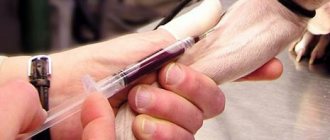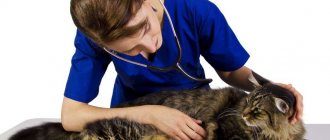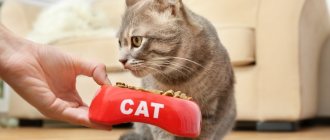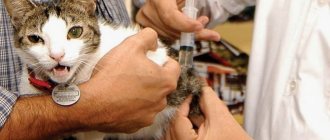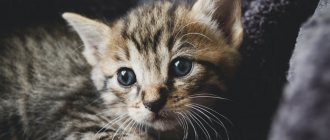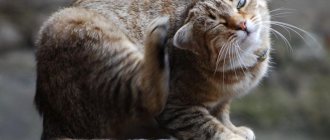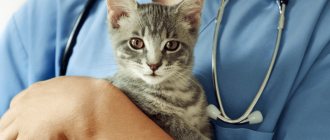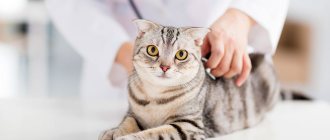If your cat's ears turn yellow despite the normal level of bilirubin in the blood, then you need to reconsider the diet: canned fish, especially tuna, cod liver, and fatty fish are prohibited. It is necessary to switch to medicated food (for example, Royal Canin Hepatic). Jaundice in a cat also occurs due to stones in the bile ducts, bladder (mechanical), liver damage due to infection, parasites, poisoning (parenchymal). Less commonly, accelerated destruction of red blood cells (hemolysis) is detected in jaundice.
To prescribe treatment, you need a veterinarian examination and blood, urine, stool, and ultrasound tests. For hepatic and hemolytic jaundice, medications are most often used in injections and droppers, and if the bile ducts are blocked, surgery may be necessary. The animal usually needs to be treated in a hospital; during home therapy, medicated food and free access to water are required.
Obstructive jaundice in cats
Obstructive jaundice in cats can be caused by a blockage in the flow of bile after it leaves the liver, which is why it is also called subhepatic. Causes the disease:
- stones in the gallbladder and ducts;
- swelling of the biliary tract due to inflammation (cholecystitis, cholangitis);
- tumor in the duodenum, pancreas;
- narrowing, protrusion of the wall or polyp at the junction of the bile duct into the duodenal bulb;
- acute inflammation of the head of the pancreas (pancreatitis).
Parenchymatous
Parenchyma is the functioning tissue, and parenchymal jaundice is the hepatic form associated with liver destruction. She is provoked by:
- hepatitis (liver inflammation) due to infection with infectious diseases;
- metabolic disorders - hepatosis;
- damage by parasites (echinococcosis, opisthorchiasis, leptospirosis);
- liver tumors or metastases from other organs;
- cirrhosis – replacement of working parenchyma with scar tissue;
- poisoning;
- the use of medications, Paracetamol is especially dangerous for cats.
Hemolytic
Hemolytic jaundice appears due to the accelerated destruction of red blood cells, it is called suprahepatic, and can be provoked by:
- parasitic infections – leptospirosis, hemobartonellosis, dirofilariasis;
- poisoning with salts of heavy metals, poison of mushrooms, plants;
- snake and insect bites;
- transfusion of incompatible blood;
- immunodeficiency;
- viral leukemia;
- specific infections – babesiosis, piroplasmosis.
Diagnostic methods
To make the correct diagnosis
For your “yellowed” pet, the veterinarian will definitely interview you in detail about the cat’s condition, nutrition, and behavior. Then he will prescribe laboratory tests such as blood biochemistry, blood sugar, coagulogram, general blood test, tests for viral infections, toxoplasmosis, parasitic infestations, and urinalysis. An ultrasound and x-ray may be necessary. Sometimes a liver biopsy is required. Thanks to these tests, the doctor will reveal where the “culprit” of jaundice is hiding and determine the disease. Having made a prompt diagnosis, a veterinarian will most likely be able to cure jaundice in a cat.
Jaundice in a cat: symptoms
Yellow mucous membrane in a cat
The main symptoms of jaundice in a cat are yellow ears and the mucous membrane of the mouth. Increased bilirubin is deposited in all organs and tissues, but it is difficult to detect that the skin has turned yellow due to the thick layer of fur; yellowness is most noticeable on the ears and abdomen; later the jaundiced coloring of the eyes becomes visible. The owner can pay attention to other signs of illness when the cat:
- turned yellow and does not eat, but drinks a lot of water;
- lethargic, does not respond to surrounding stimuli (sounds, light, smells);
- suffers from vomiting, diarrhea or constipation.
With obstructive jaundice and the parenchymal form, the feces are discolored; with all types, the urine becomes darker and foamy. When the liver and bile ducts are damaged, the abdomen is painful, and with hemolysis of red blood cells, the liver and spleen are enlarged. It is difficult to detect this on your own, but the cat may suffer from difficulty breathing and tends to lie on its back. Very severe variants of jaundice lead to brain damage, after which the cat falls into a comatose state, ending in death.
Predisposing factors
A significant predisposing factor for non-infectious liver damage is obesity. It is often accompanied by disruption of the pancreas and biliary system, and fat is deposited inside the liver tissue. Violation of bile secretion and thickening, stagnation in the ducts also causes prolonged fasting.
Predisposing factors to the disease
Jaundice is caused by high levels of bilirubin in the blood. This bile pigment is formed in the cat's body as a result of the processing of hemoglobin from red blood cells. Hemoglobin is the most important component of blood, which saturates all organs and cells with oxygen. If hemoglobin is processed too quickly, the produced bilirubin does not have time to be utilized through the liver and gradually accumulates in the body, causing intoxication.
Jaundice often occurs due to liver disease.
Often, jaundice can occur due to concomitant liver diseases (cancer, cirrhosis, hepatitis), tumors compressing the bile ducts, or due to taking certain medications. It can be triggered by rupture of the gallbladder, blood diseases, bacterial infections, obesity, the presence of worms in the body, and poor quality nutrition. Jaundice can be caused by various bacterial and viral infections, blood transfusions, hepatic lipidosis, and impaired bilirubin production.
Jaundice in a cat: how to treat
It is impossible to treat jaundice in a cat at home without examining a veterinarian, since when the liver, biliary tract and red blood cells are damaged, the schemes are completely different:
- in case of infection, drugs with an antiviral (Fosprenil) or antibacterial effect (Cefazolin) are prescribed, antiparasitic agents, immunostimulants (Gamavit, Immunofan) are used;
- to cleanse the blood of excess bilirubin, droppers with 5% glucose or Ringer's solution are placed;
- Cerucal is administered to reduce vomiting;
- Heptral, Hepatovet can help restore the liver;
- for a stone or tumor (obstructive jaundice), surgery is usually needed, and to improve the outflow of thick bile, Ursofalk suspension is needed;
- for pancreatitis, drugs are recommended to reduce the acidity of gastric juice (for example, Omeprazole);
- Vitamins B12 and folic and ascorbic acid help normalize blood composition.
Diagnostics
To diagnose jaundice and identify its cause, the following is prescribed:
- general blood, urine and stool tests;
- biochemistry of blood with the liver complex;
- blood test for infections;
- Ultrasound of the liver and biliary tract.
Typical for obstructive jaundice:
- increased alkaline phosphatase and leukocytes in the blood;
- high cholesterol and bile acids;
- stercobilin is low or absent in feces, and urobilin is absent in urine;
- Ultrasound shows stones or tumor.
With hemolytic jaundice one finds:
- decrease in red blood cells with an increase in immature forms and hemoglobin;
- increased bilirubin due to the indirect part;
- There is no bile pigment in the urine, but there is urobilin.
For the hepatic form:
- all types of bilirubin (total, direct, indirect), ALT enzymes and alkaline phosphatase are increased;
- decreased glucose and the amount of protein, especially albumin;
- There is bilirubin in the urine, and stercobilin is increased in the feces.
Diet at home
When jaundice develops, nutrition should only be therapeutic. The veterinarian may recommend Royal Canin Gastrointestinal or Hepatic, Hills Liver Protection, Farmina vet Hepatic, Happy Cat Premium diets. These foods are balanced in terms of protein, fat, and vitamins. You should not give a cat with jaundice sea fish and fatty meat, sausage, and dairy products. Restoring liver function during jaundice takes time, so gentle nutrition and medicinal food are prescribed for at least 9-12 months.
Animal care
It is important for an animal with jaundice to have free access to water; it must be changed to fresh water every day. It is necessary to feed in small portions, but often. A sick cat needs fresh air and a comfortable temperature. At high temperatures, the ears are moistened with cold water.
Treatment of pathology
Methods of influencing the manifestations of jaundice depend on the causes of the disease, the severity of damage to internal organs and the severity of symptoms. Adult cats with chronic diseases suffer for a long time. Treatment needs to be done in a hospital or at home. Therapy methods are selected by the veterinarian for each specific animal. Possible measures:
- special therapeutic food to relieve the liver (if the cat’s appetite is preserved and the cat eats on its own);
- parenteral administration of nutrients (if appetite has completely disappeared);
- intramuscular injections;
- intravenous infusions;
- blood transfusion;
- surgical intervention.
The main medications for the treatment of jaundice are presented in the table:
| Group of drugs | Impact |
| Antiemetics | Eliminates the gag reflex |
| Antiviral | Suppress pathogens |
| Detoxifiers | Removes toxic substances from the body |
| Analgesics | Helps reduce pain |
| Hepatoprotectors | Restore liver cells |
| Antibiotics | Remove pathogenic microflora |
| Hematopoiesis stimulants | Activate hematopoiesis |
| Antihistamines | Eliminate allergic manifestations |
| Immunomodulators | Increase and restore immunity |
| Anthelmintic | Remove parasites from the body |
| Vitamins | Eliminate vitamin deficiency and heal the body |
Prevention measures
In order to reduce the risk of jaundice for a cat, preventive measures are necessary:
- timely vaccination against the most common infections;
- feeding animal feed;
- avoid obesity, consult a veterinarian if you are overweight to prescribe a diet;
- take preventive medications for worms every six months;
- Do not use medications without a veterinarian's prescription.
Jaundice in a cat occurs with normal bilirubin due to excess vitamin A, but much more often it occurs due to an increase in bile pigment. For treatment, you need to find the cause - liver damage, blockage of the bile ducts or destruction of red blood cells. A cat with leptospirosis can transmit the infection to its owner.
Causes
The bile pigment bilirubin is a waste product of the breakdown of hemoglobin. Its high concentration in the blood gives the corresponding color to the mucous membranes and open depigmented areas of the skin. According to the causes of occurrence, jaundice is divided into the following types:
- hemolytic (suprahepatic);
- hepatic (parenchymal);
- mechanical (subhepatic).
Hemolytic jaundice
The reason for the increase in the concentration of bile pigment is hemolysis, that is, increased breakdown of red blood cells. Bilirubin is toxic, the body tries to get rid of it in all ways, through the mucous membranes and skin. This situation is typical for infectious diseases or poisoning. The following pathologies are contagious causes of the development of suprahepatic jaundice:
- viral infections;
- dirofilariasis – helminthic infestation;
- hemobartonellosis is a disease caused by rickettsiae that parasitize red blood cells;
- leptospirosis.
Hemolysis can be caused by insect bites or by eating rodents poisoned with anticoagulants.
Hepatic jaundice
Organ damage occurs under the influence of the following harmful factors:
- infectious diseases;
- side effects of medications;
- hepatitis;
- liver failure;
- cirrhosis;
- lipidosis;
- malignant neoplasms.
Obstructive jaundice
Caused primarily by blockage of the bile ducts for the following reasons:
- inflammation of the bladder;
- compression of the ducts of the hypertrophied pancreas;
- cholelithiasis.
Clinical signs of the disease
The clinical picture of the disease is often accompanied by anemia, signs of which may include drowsiness, slight weakness, loss of appetite and constant or periodic fever. The nature of such anemia greatly influences the general clinical signs. But in general, cats tolerate low hematocrit much more easily than dogs.
The most dangerous is hemolytic jaundice, which is characterized by the following symptoms:
The disease progresses very quickly and it is almost impossible to notice its signs in time. It is difficult to cure this type of jaundice, and the animal often dies.
Obstructive jaundice is characterized by:
Most symptoms will depend on what caused the jaundice. But the common symptoms are always yellowing and dryness of the skin and mucous membranes, constipation, nausea and vomiting, and abdominal pain. With jaundice, urine becomes bright orange, and stool becomes completely white.
Yellow staining of mucous membranes is a very dangerous symptom.
There is frequent urination and severe thirst, sudden weight loss, mental disorders and internal bleeding. In advanced cases, jaundice can result in coma and death. Therefore, it is very important to start treatment in a timely manner. Once a cat's eyeballs, gums, and inside of its ears turn yellow, it dies within a few days.
Treatment depending on the cause
The choice of treatment for jaundice in a cat depends on the cause of the disease. Therefore, it is important to conduct a thorough and detailed examination, which should include:
- Blood test - carried out to identify altered red blood cells, anemia, study liver enzymes, and assess bilirubin levels. Blood smears are also taken from the cat, the examination of which helps to identify parasites, leukemia, and leptospirosis.
- Urinalysis - allows you to detect bilirubin and urobilinogen.
- Ultrasound of the liver and radiography help determine how much the liver and spleen have increased in size, whether there are tumors and metastases.
After conducting research and establishing the exact cause of the disease, the veterinarian selects the optimal treatment regimen.
Poisoning, poisonous bites
If a cat is bitten by poisonous snakes or spiders, it is necessary to provide assistance no later than 6 hours after the incident. As treatment, the veterinarian uses steroid drugs that neutralize the effect of the poison, as well as drugs whose action is aimed at eliminating swelling and painful shock. Such medications have a positive effect only within 24 hours after receiving the bite.
In cases of severe poisoning with zinc, lead, mercury, and snake or spider venoms, the animal may need to stimulate its respiratory function. For this purpose, devices are used that provide the body with oxygen.
To remove the source of toxins, it is necessary to induce vomiting in the cat using special emetics - table salt solution, hydrogen peroxide solution.
Infectious diseases
How to treat jaundice in a cat caused by a severe infection should only be decided by an experienced specialist. Antibiotics are used to treat infectious diseases, and the choice of drug depends on the type of disease.
